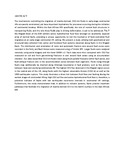| dc.contributor.author | Muirhead, J | |
| dc.contributor.author | Lee, H | |
| dc.contributor.author | Fischer, T | |
| dc.contributor.author | Kattenhorn, SA | |
| dc.contributor.author | Ebinger, C | |
| dc.contributor.author | Kianji, G | |
| dc.contributor.author | Maqway, M | |
| dc.contributor.author | Thomas, N | |
| dc.contributor.author | Onguso, B. | |
| dc.date.accessioned | 2015-05-26T06:59:05Z | |
| dc.date.available | 2015-05-26T06:59:05Z | |
| dc.date.issued | 2014 | |
| dc.identifier.citation | Muirhead J, Lee H, Fischer T, Kattenhorn SA, Ebinger C, Kianji G, Maqway M, Thomas N, Onguso B. "Fault-controlled fluid migration during early-stage continental rifting in the Magadi Basin, Kenya.". In: American Geophysical Union annual meeting, Volume: Eos, Trans. AGU 95, Fall Meet. San Francisco, CA,; 2014. | en_US |
| dc.identifier.uri | http://hdl.handle.net/11295/83641 | |
| dc.description.abstract | The mechanisms controlling the migration of mantle-derived, CO2-rich fluids in early-stage continental rifts are poorly constrained, yet have important implications for processes occurring during the initiation of continental breakup. Within the East African Rift specifically, the role of normal fault structures in transporting fluids, and the role these fluids play in driving deformation, is yet to be addressed. The 7 Ma Magadi Basin of the EAR exhibits active hydrothermal fluid flow amongst an excellently exposed array of normal faults, providing a unique opportunity to test the mechanics of fault-controlled fluid migration at an early-stage continental rift setting. We present a study utilizing both geochemical and structural data collected from active and fossilized fluid systems observed along faults in the Magadi Basin. The distribution and orientation of veins and systematic fracture sets around fault zones were recorded in the field, and fault throws were measured using a Trimble GPS. Larger faults were analyzed remotely using aerial imagery and the Aster GDEM v.2. Fault data were then compared with CO2 flux measured on soil and from gas-emitting fractures in and around fault zones using an accumulation chamber. Our data reveal that CO2-rich fluids travel along fault-parallel fractures within fault zones, and fault-oblique fracture sets in the accommodation zones between fault segments. Fluids rising through faults may additionally be diverted along lithologic boundaries in fault grabens, such as the contact between lavas and overlying sedimentary fill. The highest CO2 flux observed in the Magadi region occurs in the central axis of the rift, along faults with the highest observable throws (>150 m) as well as the 1998 earthquake rupture. This study illustrates a direct link between fluid flow and faulting during the earliest stages of continental rifting. High CO2 soil flux and active hydrothermal fluid flow is, therefore, a potential indicator of faults with low earthquake recurrence intervals in continental rift settings. Furthermore, this study demonstrates that, in addition to volcanic systems, faults provide important pathways that facilitate the migration of mantle-derived CO2 to the Earth's surface in the East African Rift. | |
| dc.language.iso | en | en_US |
| dc.publisher | University of Nairobi | en_US |
| dc.title | Fault-controlled fluid migration during early-stage continental rifting in the Magadi Basin, Kenya | en_US |
| dc.type | Presentation | en_US |
| dc.type.material | es | en_US |

